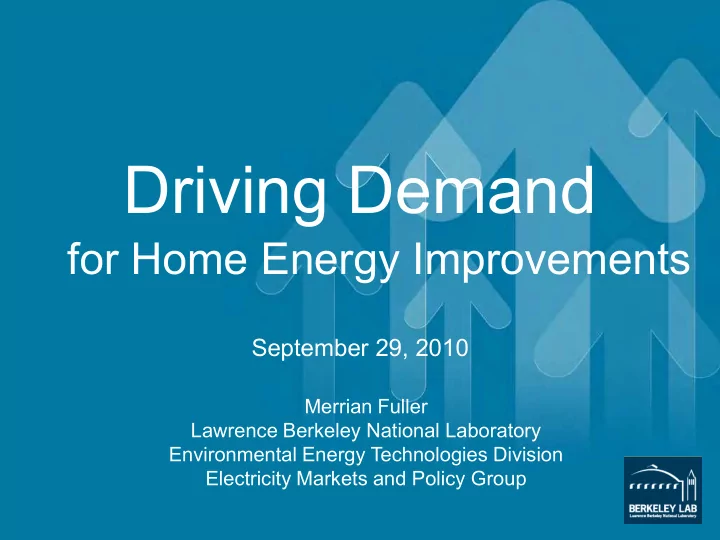

Driving Demand for Home Energy Improvements September 29, 2010 Merrian Fuller Lawrence Berkeley National Laboratory Environmental Energy Technologies Division Electricity Markets and Policy Group
Question: How can millions of Americans be persuaded to divert valued time and resources into upgrading their homes? What We Did: Case studies of 14 residential energy efficiency programs Review of relevant marketing and behavioral research reports and presentations Phone survey of 30 home performance contractors Interviews with key experts Report, listserves, upcoming & past webinars, and other resources: http://drivingdemand.lbl.gov/ 2
Charting New Territory Limited success to date motivating large numbers of Americans to invest in comprehensive home energy improvements, especially if they are being asked to pay for a majority of the improvement costs. But we can learn from past programs… 3
What We Cover “Retrofits” are a Tough Sell o Lessons from Behavioral Research o Engage Trusted Messengers o Work Closely With Contractors o Identify the Target Audience o Sell Something People Want o Language Matters o Design and Evaluate Programs to Learn What Works o 4
“Retrofits” are a Tough Sell • Programs must make an appealing case to potential customers, many of whom are not currently interested in upgrading their homes. • Demands on homeowners, particularly around time and effort, must be minimized. Consolidate the number of steps required. Participants drop out with each step and with each time delay. 5
Lessons from Behavioral Research • Simply providing information and financing is insufficient to incentivize widespread home energy improvements. • Social norms, competition, public commitment and feedback may all be useful tools to guide program design. • Single Action Bias vs. Small Concessions – There may be a tendency towards a “single action bias” – people do one thing and consider themselves done. – Programs that opt for a “small concessions” approach need to make sure that participants understand that this is just the first step (and the fewer steps the better). 6
Engage Trusted Messengers • Start with local opinion leaders. Involving local opinion leaders to promote a program takes advantage of existing social relationships and networks. • Model success. The stories – told both in person and through marketing media – of early adopters/opinion leaders who have successfully gone through the program can attract others. • Encouraging personal contact with peers. Person- to-person communication with peers can be one of the more effective ways to motivate action, especially if the “messenger” is someone the potential participant already knows and trusts. • Local control. Allow the local community to have ownership of the program. • Get buy-in from local organizations. Ask for the support of respected local organizations, especially nonprofits. 7
Partner with contractors • Contractors will be the primary sales force for most programs • Design a program that contractors want to sell • Consider sales training & marketing incentives for contractors • Not all contractors have the same business model – structure incentives to move contractors toward more comprehensive upgrades 8
Identify the Target Audience You will not be able to reach everyone in the initial launch, in fact, it may be prohibitively expensive to do so effectively. • Focus on the early adopters in the beginning stages of a program. • Use focus groups and market segmentation research to identify the target audience; understand the specific barriers and effective messages to reach this audience. • Consider targeting by: o Demographics o Values o Hot issues o Potential for savings o Entry point 9
Sell Something People Want Comfort: Increase your family’s comfort and wellbeing. Practical Investment: Make an investment to protect and maintain your most valuable asset. Self-Reliance: Become a self-reliant American – reduce your energy dependence. Social Norm: All of your neighbors are making home energy improvements. Health: Protect your family from mold allergies and asthma. Community: Join your neighbors in supporting local prosperity, reducing energy waste, and protecting the environment for future generations. 10
Language Matters • Words have power – programs should choose the language they use carefully. The terms “audit” and “retrofit” are not effective. • Communication style matters, and this can require training to get right. Programs should consider using vivid examples, personalizing information, using statements of loss rather than gain, and inducing a commitment from the homeowners. 11
Pilot, Experiment, Measure… Know success and failure by measuring it, and experiment to figure out what works • Design for data collection and evaluation at the start to allow Mid-stream adjustments Better selection among strategies Knowing success when it arrives • Pilot pilot pilot - It is important to pilot strategies before launching full-scale programs and to test a variety of strategies to learn what works. • Look at the all in costs of the program – including all direct and indirect staff time, incentives, marketing materials, etc – and come up with a cost per home upgraded. How does this return on investment compare to other strategies available? 12
Resources Join the Driving Demand email listserve (announcements only or the discussion group) Upcoming Driving Demand Webinars • Tuesday, October 19 at 2:00-3:15 ET Case studies from the field Contact • Tuesday, November 9 at 2:00-3:15 ET Case studies from the field Merrian Fuller Lawrence Berkeley National Lab http://drivingdemand.lbl.gov/ mcfuller@lbl.gov 510-486-4482 13
Recommend
More recommend